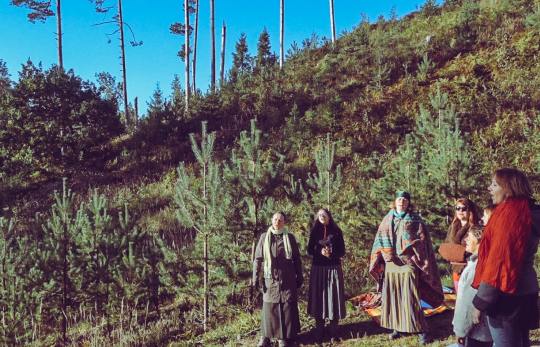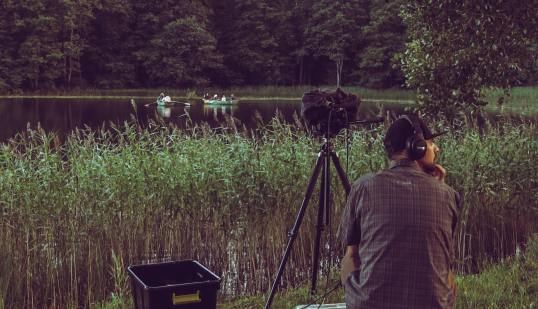|
Saucējas, formed in 2003 but with a line-up that evolves through the years, is the female traditional polyphonic vocal group of the Latvian Academy of Culture. But don't let the academic connection deter you; their Womex 2019 showcase proved their live performance is far from dull or academic, and their songs, while learned from archive recordings and their own fieldwork, and using traditional techniques and harmonies, emerge their own expression.
It might appear just a conceptual decision to record in natural environments, but apart from undoubtedly being a lot more inspiring and fun than standing in a studio, as Saucējas leader Iveta Tāle describes in the CD booklet (and more extensively in her book that can be had as a companion to the recordings), singing outdoors in resonant places, particularly on a hill or in the forest, was a strong aspect of the tradition and often referred to in people's reminiscences and in the lyrics of the songs themselves. There are references to weather conditions too (alfresco singing being mostly in the warmer months) and the time of day. There's a satisfaction in singing loud outdoors, the space and reverberation encouraging the singer and giving a feeling that their voice is being carried to the world.

This double CD of the ten-member vocal ensemble, with sixty traditional songs recorded in various outdoor locations, is a remarkable piece of work. Recording them, during the years 2017-2020, wasn't simply a matter of standing outdoors somewhere and being recorded. The locations, and positioning of the singers within them, and were carefully chosen. There are fourteen locations, including hills, a forest, meadows, the slope under a hill-fort, the banks of a lake and a river, a farmyard and around a bonfire.
Multiple mics were used, to record the singers from different directions and grouped in different places and simultaneously record the environment. The reverb is often so perfect, and the sounds of birds and other animals so strong, that the first assumption is that they were added in the studio, but not so. Everything was live. I checked with Gatis Gaujenieks (of the band Iļģi), who with Edmunds Račinskis did the recording, and he described the process:
| “A pair of microphones was aimed at the singers while another pair pointed away. It was a long experimental procedure to achieve a sonic image where the listener would hear Saucējas from afar. I can swear that all the birds, frogs, wind, turkeys are even cows (one who took a long substantial piss not 2 meters from my mic position - that recording did not make it to the finals!)
“The birds did indeed react to the singers. Once Saucējas began singing, the birds more often than not joined in, as if they were defending their territory from these singing strangers.
“The process was quite interesting and in the 3rd and 4th years, weather permitting (wind and rain noises were major problems at times) we were able to make the more complex recordings where three groups of singers, at different positions were placed so that they were in unique positions in the stereo image, so that each group could be distinguished. It is easy in the studio to turn something panned left or right, but here I had singers move over to the left, right or center another 60 meters, turn partly or completely away from the microphones to avoid the signal being too direct, all to enhance the ambience of the overall recording.

“In the studio the overall balance of singers to ambience was checked. Recordings done earlier in the project tend to be ‘drier' than the latter ones because of the earlier recording setup. Some equalization and filtering was done on a few recordings to remove excess wind noise, rumble or some other disturbing natural (flies buzzing the mics) and non-natural sounds. So again, every performance is live, including the wildlife and natural acoustics of the places where we recorded. It was a long, challenging project, but a rewarding one.”
|
Freedom of independent lines, drones with voices departing from them in very close intervals, and call-and-response, are strong features of the recordings, while some songs have more church-like harmonisation and structure. Some listeners will, I guess, draw parallels with Bulgaria's female vocal ensembles, but while there are some common features in the subject matter of these songs – spring and summer seasonal songs, communal work songs, shepherds' songs, wedding songs, calls – and in some of the harmonisations, Latvia is two thousand kilometres north of Bulgaria, with a different culture and not mountainous, and the loud ‘wide throat' voices, while sometimes described in the songs in terms of various metals, differ from those of Bulgaria.

|
|
""
|
I'm inclined to recommend playing CD2 first because it has a particularly alluring opening, “Kas visiem(i) bāriņiemi,” a spring song recorded in the evening of May 3rd 2020 on the banks of the river Salaca, the singing slow, wide and plaintive, with the sounds of the water and birds.
The shepherds' song that follows it, “Kā tā māva raibuliņa,” recorded at the same time and place, has the voices crossing from different positions and whooping into the natural reverb. But jump in anywhere on either CD, right through to the cascading voices of separate groups spaced near and distant in the 'long call' of the final track, and you'll find something striking.
Find the artists online
Further reading:
Tautumeitas
Ilgi
The Latvian Folk Music Collection
|
